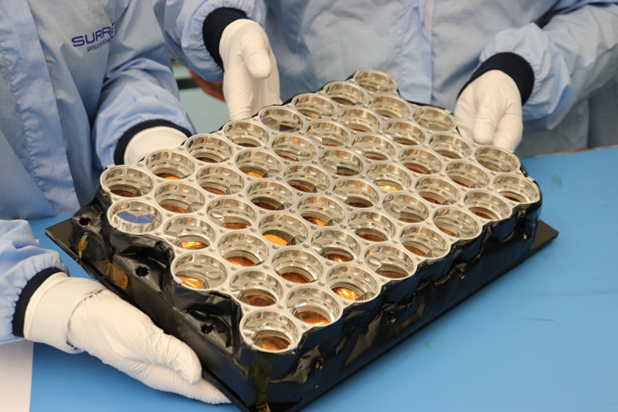
Safeguarded within multiple layers of packaging, NASA’s Laser Retroreflector Array, LRA, was successfully delivered to SSTL. After unpacking, a visual inspection of the LRA was jointly performed by ESA, NASA and SSTL, confirming there are no scratches and nicks in the optics. As a result, the instrument was formally accepted by ESA on 4th of November 2022 and was passed to SSTL for integration aboard Lunar Pathfinder.
SSTL’s Lunar Pathfinder will serve as a telecommunications relay satellite for future missions to the Moon, and NASA will make use of its services in exchange of delivering Lunar Pathfinder to lunar orbit through the Commercial Lunar Payload Services (CLPS) initiative. “Today’s delivery is an additional element of this unique ESA-NASA collaboration, which includes an original in-orbit test campaign to demonstrate the use of satellite navigation signals and laser ranging to achieve a satnav positioning fix in lunar orbit for the first time”, explains Javier Ventura-Traveset, leading ESA’s Galileo Navigation Science Office and coordinating ESA lunar navigation activities.
“Both NASA and ESA are highly interested in exploiting the LRA data with our NaviMoon satnav receiver capabilities, which will enable the cross-checking of NaviMoon’s positioning fixes across cislunar distance and open up new possibilities in lunar geodesy. These tests will also provide a very valuable technological learning towards Moonlight, which will provide before the end of this decade an autonomous network of communications and navigation satellites supporting Lunar exploration.”
Laser retroreflectors are well-established space technology that by measuring the time of flight for the laser pulses to travel from Earth to the satellite and back, allow its precise distance can be calculated. In approach they resemble the mirrored ‘cat’s eyes’ embedded in motorways to reflect light precisely back to its source, thanks to an intricate internal reflection setup – a total of 48 ‘corner cubes’ in the case of the LRA, which were individually and rigorously inspected and measured in the laboratory. The optical performance of the array was accurately measure at NASA Goddard Space Flight Center.
NASA’s delivered laser retroreflector array (LRA), with its 48 corner cubes at 1.6 inches in diameter – Credit SSTL
“This is SSTL’s first piece of Lunar Pathfinder project flight hardware and is the result of an excellent collaboration between ESA, NASA and SSTL. The novel combination of Laser, GNSS and X-Band ranging is an exciting prospect with a lot of experience, hard work and dedication being put in to ensure that this pathfinding experiment will provide the expected results. We are all eager to put this ranging experiment to the test once SSTL’s Lunar Pathfinder has launched. For now, it is exciting to have these two hosted payloads on site at SSTL in preparation for integration onto the Lunar Pathfinder spacecraft which will help pave the way for SSTL’s future Lunar ambitions.” As stated by Lily Forward, SSTL Lunar Pathfinder Systems Engineer.
About the size of a laptop, the LRA was produced for NASA by KBR, based on a previous LRA already flying on NASA’s Lunar Reconnaissance Orbiter (LRO). "This LRA is larger and will return more than twelve times the laser light than the one on LRO since it has 48 corner cubes at 1.6 inches in diameter, compared to LRO’s 12 reflector cubes at 1.2 inches in diameter. This opportunity is then rather unique.” As stated by Stephen Merkowitz, NASA Space Geodesy Project Manager.
SSTL’s Lunar Pathfinder will orbit in a highly elliptical ‘Lunar Frozen Orbit’, designed to optimise coverage over the Moon’s South Pole, the primary focus of future exploration efforts. For this demonstration, the Lunar Pathfinder satellite will be reoriented in orbit, on typical 5 days continuous experimental windows, so that the LRA, the NaviMoon receiver antenna and the X-Band transponder ranging, all located on the same panel of the satellite, point towards Earth. This will maximise the attainable performances and the joint visibility of these three geodetic techniques, which will be used simultaneously for the first time ever on lunar orbit.
Javier Ventura-Traveset from ESA, Stephen Merkowitz from NASA and Lilly Forward from SSTL during the formal LRA acceptance at SSTL clean-room facilities in Guildford, Surrey, UK. - Credit SSTL
